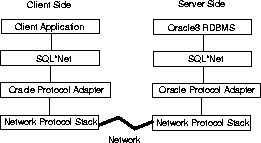| Oracle Network Products Getting Started for Windows Platforms | Library |
Product |
Contents |
Index |
| Oracle Network Products Getting Started for Windows Platforms | Library |
Product |
Contents |
Index |
Oracle Connectivity Overview
Oracle Network Products' main function is to establish sessions and transfer data between a client and a server or between the two servers. Most of the activity occurs at the beginning when setting up the session. Once the session is established, Oracle Network Products' main job is to act as a data courier for the client and server. Architectural Overview
Forming the foundation of Oracle Network Products is SQL*Net. SQL*Net uses the Transparent Network Substrate (TNS) and industry-standard network protocols (such as TCP/IP) to connect a client to a server and establish an Oracle session. Figure 1-1 shows the basic connectivity architecture:

Figure 1¯1 SQL*Net Connectivity Architecture
Following is an overview of the Oracle network connectivity components: SQL*Net
The role of SQL*Net is to establish and maintain a connection between the client application and the server and exchange messages between them. SQL*Net is a software layer that is required to communicate between Oracle clients and servers. It provides both client-server and server-server communications across any network. It enables client tools to access, modify, share, and store data on Oracle7 servers over a network. The communication between client applications and servers takes place across one or more networks, and is referred to as client/server communication. Oracle Protocol Adapters
The Oracle Protocol Adapters are responsible for mapping TNS functionality to industry-standard protocols used in the client/server connection. Each adapter is responsible for mapping the equivalent functions between TNS and a specific protocol.
|
|
Network-Specific Protocol Stack
The network protocol stack, not provided by Oracle, supplies a reliable means of communication. Client/Server Interaction
This section describes a basic client/server connection. New Features with Version 2.3.3
SQL*Net and Oracle Network Products include the following new features:
|
Prev Next |
Copyright © 1996 Oracle Corporation. All Rights Reserved. |
Library |
Product |
Contents |
Index |